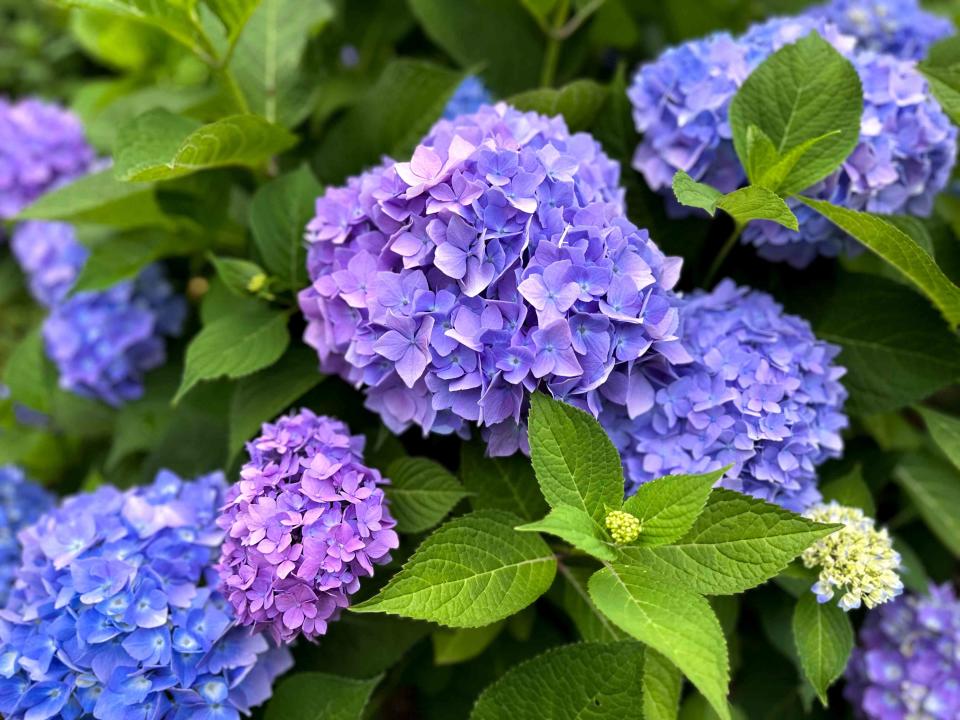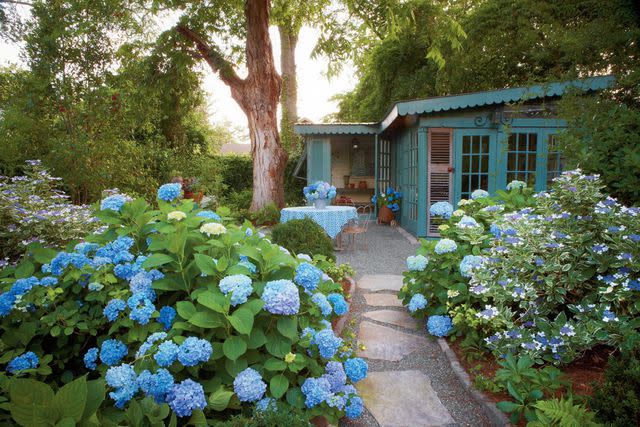Here's When To Plant Hydrangeas, According To Experts
Learn the best time to plant hydrangeas for successful growth and blooming.

Getty Images / Catherine McQueen
Hydrangeas are much-loved flowering shrubs for their gorgeous flowers, long bloom time, and sheer number of varieties. They’re also favorites of pollinators and will adapt to many different types of soils. With new hydrangeas introduced all the time, there’s a variety that’s perfect for nearly every garden. If you're looking to plant new hydrangeas in your garden, the fall is the best time to plant them, according to experts.
Meet The Experts
Judson LeCompte, Ph.D. is the product development assistant manager with Spring Meadow Nursery.
Karen Bunting is the business development manager for potted plants with Ball Seed.
Hydrangeas are not fussy, as long as you pay attention to their needs. “They’re easy care shrubs, if planted in the right place,” says Judson LeCompte, Ph.D., product development assistant manager with Spring Meadow Nursery. “If you can grow azaleas, hydrangeas will be happy, too, because they like acidic soil like azaleas.” A soil test can identify your garden’s pH so you can give your plant its best start in life.
Depending on the species, hydrangeas grow in USDA Hardiness zones 3 to 9 (find your zone here). They’ve also been bred to range in size from a petite 1 to 2 feet tall to climbing hydrangeas that can reach up to 50 feet tall, all the way up a tree, says LeCompte. But be aware that they are tasty to deer, so they’re not always a great choice if deer frequent your garden.
Probably the most important thing to remember about growing hydrangeas in the South is to make sure to give them afternoon shade, says LeCompte. Some types, such as Hydrangea arborescens, require all day shade in the South.
Keeping hydrangeas watered is another must. “Hydrangeas require plenty of water, regardless of the climate,” says Karen Bunting, business development manager for potted plants with Ball Seed. “Even once established, hydrangeas may need supplemental water through the hotter months.”
Related: 8 Mistakes You Should Never Make With Your Hydrangeas
Types of Hydrangeas To Plant in the Southeast
Many types of hydrangeas will grow in the Southeast, if you give them the right conditions, says LeCompte. That includes:
Hydrangea macrophylla, also known as big leaf, mophead or lacecap hydrangea
Hydrangea paniculata, also called peegee or panicle hydrangea
Hydrangea arborescens, a native species also known as smooth hydrangea
Hydrangea serrata, or mountain hydrangea, which is more cold-hardy than other types
Hydrangea quercifolia, also known as oakleaf hydrangea
Hydrangea petiolaris, or climbing hydrangea, a vining plant
However, both LeCompte and Bunting agree that the best types of hydrangeas for the Southeast are the paniculata and quercifolia types because they’re generally more forgiving about heat and drought conditions.
Best Time To Plant Hydrangeas in the Southeast
Hydrangeas will do best if you don’t stress them by planting right before the hottest part of the year. “The best time to plant hydrangeas is in the fall because the conditions are less harsh than in summer, and the plant has all winter to get its roots established,” says LeCompte. “Also, the plant has no leaves and will not be transpiring or losing moisture.”
While not ideal, you also can plant hydrangeas in early spring after the last frost in your area, says LeCompte. But be aware that planting early in the year is a little trickier because a hydrangea planted in spring must get through the toughest growing conditions of the season with the summer months ahead of it. “Planting in spring, and keeping them well-watered through spring, summer and fall, can be tricky,” says Bunting.
Tips for Planting Hydrangeas
Find a spot with morning sun and afternoon shade. Hydrangeas need some sun in order to bloom well, but they will not be happy baking in the hot afternoon sun, says LeCompte. Watch your landscape for a few days so you can be sure the area where you want to plant receives shade during the hottest part of the day.
Next, dig a hole about twice as wide as the container, but at the same depth as the shrub is in the pot. “The biggest mistake I see is people planting shrubs too deep,” says LeCompte. Slide the shrub out of the pot, then rough up the root ball with your gloved hand to help loosen up any roots that were circling around inside the pot.
Place the plant in the hole, and backfill the soil you excavated, pressing down firmly to eliminate air pockets. Don’t add anything such as peat moss or compost directly to the hole because this will cause drainage problems down the road, says LeCompte. When you amend the soil in the hole itself, this encourages the plant’s roots to stay in the hole, rather than expanding into the surrounding area. The shrub needs to learn to grow in its native soil.
Next, water the root area (not the foliage) deeply. For the rest of the season, water deeply and infrequently, rather than giving it a small drink every day; you want to saturate the base of the plant, let it dry a bit, then water deeply again. Finally, mulch with two to three inches of organic mulch, such as cedar mulch or pine straw, to conserve water and keep the roots cool, says LeCompte.
Caring for Hydrangeas
Hydrangeas sometimes wilt throughout the day—even if they have sufficient water—because their large leaves transpire faster than they can pull moisture up from the soil in the heat and humidity of the day. Don’t panic! Poke your finger into the soil; if it’s moist, wait and see what happens. The plant should perk up again by the next morning, says LeCompte.
However, if it’s bone-dry when you test, it’s fine to water, says LeCompte. Water the root ball deeply. You want the soil to feel moist around the plant, not soaking wet. By the second season in the ground, you usually don’t need to add supplemental watering unless you’re experiencing extreme drought conditions.
The shrub will have enough fertilizer to last the first season, says LeCompte. But next spring, you can feed it, if you like, with a granular controlled release fertilizer for acidic plants, such as HollyTone.
Don’t forget that hydrangeas still are growing in the fall, so go ahead and keep watering deeply all the way through autumn. “Remember that root growth continues in the fall, even when we don’t see top growth on plants,” says Bunting. “Don’t quit watering going into the fall.”

Can You Change the Color of Hydrangea Flowers?
It depends! The truth is that only some types of big leaf and mountain hydrangeas change flower color in response to the presence of aluminum in the soil, not the soil pH, says LeCompte. No matter what you’ve heard—or seen on social media—adding a penny or nails or whatever else to your soil isn’t going to change the flower color.
Related: The Right Time To Prune Hydrangeas Depends On The Variety
For more Southern Living news, make sure to sign up for our newsletter!
Read the original article on Southern Living.

